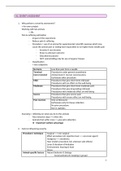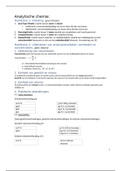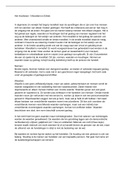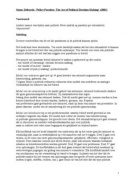H1: SEVERITY ASSESSMENT
1. Why perform a severity assessment?
= for every project
Working with lab animals
= 3Rs
Pain & suffering estimation
- Impact of the experiment
- Reduce pain & suffering
- Procedure = use of an animal for experimental/ scientific purpose which may
cause the animal pain or lasting harm equivalent to (or higher than) needle pain
- Invasive & non invasive
- Know & unknown outcome
- Educational purpose
- NOT: animal killing only for use of organs/ tissues
- Classification
= very subjective
No harm Less than pain from a needle
Terminal Procedures under general anaesthesia
(non-recovery) Animal doesn’t recover consciousness
Euthanasia after procedure
Mild Procedures that give short-term mild pain
Procedures with no effect on the well-being
Moderate Procedures that give short-term moderate pain
Procedures that give long-lasting mild pain
Procedures with moderate effect on well-being
Severe Procedures that give severe pain
Procedures with severe effect on well-being
Post mortem Only at KULeuven
Euthanasia only for tissue collection
No prior procedure
Not in statistics
Assessing = reflecting on what you do to the animals
- Pain/stressful steps => refine this
- Animals that suffer more => give extra attention
Important welfare advantage
2. Factors influencing severity
Procedure/ technique Surgical <-> non-surgical
Effect procedure (vb: injection toxic <-> non-toxic agent)
Analgesia <-> anesthesia
New model/ procedure (vb: unknown side-effects)
Lever & duration of limitation
Environment: housing & food
Stress
Animal-specific factors Natural behavior & biology
- Social animals (vb: keeping in group)
1
, - Senses (vb: eyes important for primate)
Strain & phenotype
(vb: immunodeficient mice have special needs to not get sick)
Gender, age,…
(vb: 10% weight loss more severe in young animal)
Frequency, intensity, More frequent ≠ more severe
duration - Trained animals
- Anticipation of stressful event => more severe
Refinement Reduce severity
Analgesia: severe -> moderate
Enrichment, housing, care
- Reduce stress
Bad care
- Metabolic cage
- Solitary housing
- No enrichment
Increase stress
No influence = non-procedural issues
- Cage flooding
- Fighting
- Sickness, trauma
They still do affect animal welfare
3. Actual & prospective severity
Prospective Actual
At time of project writing Differ from expected severity
Assumption about severity Highest suffering during his life
Before experiment Based on animal’s own experience
Numbers for statistics
Less severe = control animals
More severe = unexpected side effects
4. Assessing severity in practice
STAP 1: DEFINE WHAT STUDY DOES TO ANIMALS
STAP 2: DEFINE WHAT ANIMALS WILL EXPERIENCE
= adverse effects
STAP 3: DEFINE HOW YOU WILL REFINE FOR EACH STEP
= humane endpoints
STAP 4: DECIDE ON SEVERITY
H2: LEGISLATION
1. Numbers
Animal use is fluctuating
Decrease Increase
Alternatives, ethics, legislation Transgenic animals
Responsible use
High costs
2
,2. What does the law say
Definition of laboratory animal Every living vertebrate
- Including: larval forms
- Used for experiments
- Excluding: foetus & embryo
New law
- Include invertebrae
- Include mammalian embryo (last third)
Definition of animal Use of living vertebrate for experimental purpose
experiment - Can give pain
- Include: treatment that has the aim of the birth
of an animal in such a condition
- Exclude: humane methods
= least painfull, kill & mark animal
- Exclude: non-experimental treatments in
agriculture/ veterinary
Legislation Pain was not defined
Now: taken up in new European Directive
= only one use of animal in experiment that gives
serious pain
Purpose of animal use Production & control of sera, vaccines of diagnostics
Toxicological & pharmacological research
Diagnose of diseases
Education
Answer scientific questions
NOT: cosmetic product testing
Housing & taking care Meet animal’s need
Daily control
Regular control by veterinarian or expert
Source & identification No stray, lost or abandoned animals
Purpose-bred by licensed companies
Farm animals
Special demands for endangered animals
Dogs, cats & primates
- Individual marking
- Immediately after weaning
Register all animals joining & leaving
Statistical information Every year to the government
- Numbers used per species
- Numbers per type of experiment
Responsible use Experiments
- Absolute minimum
- Only if there is no alternative method
- Seriously consideration
- Lowest neurophysiological degree
Analgesia => decrease pain
Never serious pain
Pain cannot be avoided => anaesthesia
3
, 3. 3 R’s
= principles of humane experimental technique
Reduction Replacement Refinement
Experiment design chose Replacing animals Less discomfort
Standardising animal Other methods Biological needs animal
population and procedures Invertebrate Environment enrichment
Analgesia
4. What to do before starting experiment
a. Laboratory licence
Federal public service – Animal Welfare
- Room overview = map
- Overview of kind of experiments
- List of species & sources
- Staff overview
- Laboratory director = responsible manager
- Expert = protection of health & well-being
Large = veterinarian
Small = FELASA C training
- Project leader = experiment set up, log keeping
- Biotechnicians = conduct experiments
- Animal caretakers
b. Permission of ethical committee
Tasks Evaluation of planned experiments
Ethical criteria set up
Advising labo’s and government
Reporting government
Keeping it a secret
Members Laboratory director
Project leader
Veterinarian or expert
Biotechnician
2 independent members
Apply for permission Staff responsible for project
Purpose & description
Numbers of species, degree & duration of pain
Anaesthesia and analgesia used, post operative care
Alternative methods
Humane endpoint and euthanasia
c. Education FELASA
A) Animal caretakers = 25h
B) Researchers, lab technicians = 40h
C) Project leaders = 80h
4
1. Why perform a severity assessment?
= for every project
Working with lab animals
= 3Rs
Pain & suffering estimation
- Impact of the experiment
- Reduce pain & suffering
- Procedure = use of an animal for experimental/ scientific purpose which may
cause the animal pain or lasting harm equivalent to (or higher than) needle pain
- Invasive & non invasive
- Know & unknown outcome
- Educational purpose
- NOT: animal killing only for use of organs/ tissues
- Classification
= very subjective
No harm Less than pain from a needle
Terminal Procedures under general anaesthesia
(non-recovery) Animal doesn’t recover consciousness
Euthanasia after procedure
Mild Procedures that give short-term mild pain
Procedures with no effect on the well-being
Moderate Procedures that give short-term moderate pain
Procedures that give long-lasting mild pain
Procedures with moderate effect on well-being
Severe Procedures that give severe pain
Procedures with severe effect on well-being
Post mortem Only at KULeuven
Euthanasia only for tissue collection
No prior procedure
Not in statistics
Assessing = reflecting on what you do to the animals
- Pain/stressful steps => refine this
- Animals that suffer more => give extra attention
Important welfare advantage
2. Factors influencing severity
Procedure/ technique Surgical <-> non-surgical
Effect procedure (vb: injection toxic <-> non-toxic agent)
Analgesia <-> anesthesia
New model/ procedure (vb: unknown side-effects)
Lever & duration of limitation
Environment: housing & food
Stress
Animal-specific factors Natural behavior & biology
- Social animals (vb: keeping in group)
1
, - Senses (vb: eyes important for primate)
Strain & phenotype
(vb: immunodeficient mice have special needs to not get sick)
Gender, age,…
(vb: 10% weight loss more severe in young animal)
Frequency, intensity, More frequent ≠ more severe
duration - Trained animals
- Anticipation of stressful event => more severe
Refinement Reduce severity
Analgesia: severe -> moderate
Enrichment, housing, care
- Reduce stress
Bad care
- Metabolic cage
- Solitary housing
- No enrichment
Increase stress
No influence = non-procedural issues
- Cage flooding
- Fighting
- Sickness, trauma
They still do affect animal welfare
3. Actual & prospective severity
Prospective Actual
At time of project writing Differ from expected severity
Assumption about severity Highest suffering during his life
Before experiment Based on animal’s own experience
Numbers for statistics
Less severe = control animals
More severe = unexpected side effects
4. Assessing severity in practice
STAP 1: DEFINE WHAT STUDY DOES TO ANIMALS
STAP 2: DEFINE WHAT ANIMALS WILL EXPERIENCE
= adverse effects
STAP 3: DEFINE HOW YOU WILL REFINE FOR EACH STEP
= humane endpoints
STAP 4: DECIDE ON SEVERITY
H2: LEGISLATION
1. Numbers
Animal use is fluctuating
Decrease Increase
Alternatives, ethics, legislation Transgenic animals
Responsible use
High costs
2
,2. What does the law say
Definition of laboratory animal Every living vertebrate
- Including: larval forms
- Used for experiments
- Excluding: foetus & embryo
New law
- Include invertebrae
- Include mammalian embryo (last third)
Definition of animal Use of living vertebrate for experimental purpose
experiment - Can give pain
- Include: treatment that has the aim of the birth
of an animal in such a condition
- Exclude: humane methods
= least painfull, kill & mark animal
- Exclude: non-experimental treatments in
agriculture/ veterinary
Legislation Pain was not defined
Now: taken up in new European Directive
= only one use of animal in experiment that gives
serious pain
Purpose of animal use Production & control of sera, vaccines of diagnostics
Toxicological & pharmacological research
Diagnose of diseases
Education
Answer scientific questions
NOT: cosmetic product testing
Housing & taking care Meet animal’s need
Daily control
Regular control by veterinarian or expert
Source & identification No stray, lost or abandoned animals
Purpose-bred by licensed companies
Farm animals
Special demands for endangered animals
Dogs, cats & primates
- Individual marking
- Immediately after weaning
Register all animals joining & leaving
Statistical information Every year to the government
- Numbers used per species
- Numbers per type of experiment
Responsible use Experiments
- Absolute minimum
- Only if there is no alternative method
- Seriously consideration
- Lowest neurophysiological degree
Analgesia => decrease pain
Never serious pain
Pain cannot be avoided => anaesthesia
3
, 3. 3 R’s
= principles of humane experimental technique
Reduction Replacement Refinement
Experiment design chose Replacing animals Less discomfort
Standardising animal Other methods Biological needs animal
population and procedures Invertebrate Environment enrichment
Analgesia
4. What to do before starting experiment
a. Laboratory licence
Federal public service – Animal Welfare
- Room overview = map
- Overview of kind of experiments
- List of species & sources
- Staff overview
- Laboratory director = responsible manager
- Expert = protection of health & well-being
Large = veterinarian
Small = FELASA C training
- Project leader = experiment set up, log keeping
- Biotechnicians = conduct experiments
- Animal caretakers
b. Permission of ethical committee
Tasks Evaluation of planned experiments
Ethical criteria set up
Advising labo’s and government
Reporting government
Keeping it a secret
Members Laboratory director
Project leader
Veterinarian or expert
Biotechnician
2 independent members
Apply for permission Staff responsible for project
Purpose & description
Numbers of species, degree & duration of pain
Anaesthesia and analgesia used, post operative care
Alternative methods
Humane endpoint and euthanasia
c. Education FELASA
A) Animal caretakers = 25h
B) Researchers, lab technicians = 40h
C) Project leaders = 80h
4








